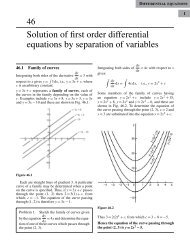differentiation
You also want an ePaper? Increase the reach of your titles
YUMPU automatically turns print PDFs into web optimized ePapers that Google loves.
302 DIFFERENTIAL CALCULUS<br />
height reached, (d) the velocity with which<br />
the missile strikes the ground.<br />
[ ]<br />
(a) 100 m/s (b) 4s<br />
(c) 200 m<br />
(d) −100 m/s<br />
2. The distance s metres travelled by a car in t<br />
seconds after the brakes are applied is given<br />
by s = 25t − 2.5t 2 . Find (a) the speed of the<br />
car (in km/h) when the brakes are applied,<br />
(b) the distance the car travels before it stops.<br />
[(a) 90 km/h (b) 62.5 m]<br />
3. The equation θ = 10π + 24t − 3t 2 gives the<br />
angle θ, in radians, through which a wheel<br />
turns in t seconds. Determine (a) the time<br />
the wheel takes to come to rest, (b) the<br />
angle turned through in the last second of<br />
movement.<br />
[(a) 4 s (b) 3 rads]<br />
4. At any time t seconds the distance x metres<br />
of a particle moving in a straight line from<br />
a fixed point is given by x = 4t + ln(1 − t).<br />
Determine (a) the initial velocity and<br />
acceleration (b) the velocity and acceleration<br />
after 1.5 s (c) the time when the velocity is<br />
zero.<br />
⎡<br />
(a) 3 m/s; −1m/s 2 ⎤<br />
⎢<br />
⎣<br />
(b) 6 m/s; −4m/s 2<br />
⎥<br />
⎦<br />
(c) 3 4 s<br />
5. The angular displacement θ of a rotating disc<br />
is given by θ = 6 sin t , where t is the time in<br />
4<br />
seconds. Determine (a) the angular velocity<br />
of the disc when t is 1.5 s, (b) the angular<br />
acceleration when t is 5.5 s, and (c) the first<br />
time when the angular velocity is zero.<br />
⎡<br />
(a) ω = 1.40 rad/s<br />
⎤<br />
⎢<br />
⎣(b) α =−0.37 rad/s 2 ⎥<br />
⎦<br />
(c) t = 6.28 s<br />
6. x = 20t3<br />
3 − 23t2 + 6t + 5 represents the distance,<br />
x metres, moved by a body in t seconds.<br />
2<br />
Determine (a) the velocity and acceleration<br />
at the start, (b) the velocity and acceleration<br />
when t = 3 s, (c) the values of t when the<br />
body is at rest, (d) the value of t when the<br />
acceleration is 37 m/s 2 and (e) the distance<br />
travelled in the third second.<br />
⎡<br />
(a) 6 m/s; −23 m/s 2 ⎤<br />
(b) 117 m/s; 97 m/s 2<br />
3<br />
(c)<br />
⎢ 4 sor 2 5 s<br />
⎣(d) 1<br />
2 1 s<br />
⎥<br />
⎦<br />
(e) 75 1 6 m<br />
28.3 Turning points<br />
In Fig. 28.4, the gradient (or rate of change) of the<br />
curve changes from positive between O and P to<br />
negative between P and Q, and then positive again<br />
between Q and R. At point P, the gradient is zero<br />
and, as x increases, the gradient of the curve changes<br />
from positive just before P to negative just after. Such<br />
a point is called a maximum point and appears as<br />
the ‘crest of a wave’. At point Q, the gradient is also<br />
zero and, as x increases, the gradient of the curve<br />
changes from negative just before Q to positive just<br />
after. Such a point is called a minimum point, and<br />
appears as the ‘bottom of a valley’. Points such as P<br />
and Q are given the general name of turning points.<br />
Figure 28.4<br />
It is possible to have a turning point, the gradient<br />
on either side of which is the same. Such a point is<br />
given the special name of a point of inflexion, and<br />
examples are shown in Fig. 28.5.<br />
Maximum and minimum points and points of<br />
inflexion are given the general term of stationary<br />
points.<br />
Procedure for finding and distinguishing<br />
between stationary points:<br />
(i) Given y = f (x), determine dy<br />
dx (i.e. f ′ (x))










